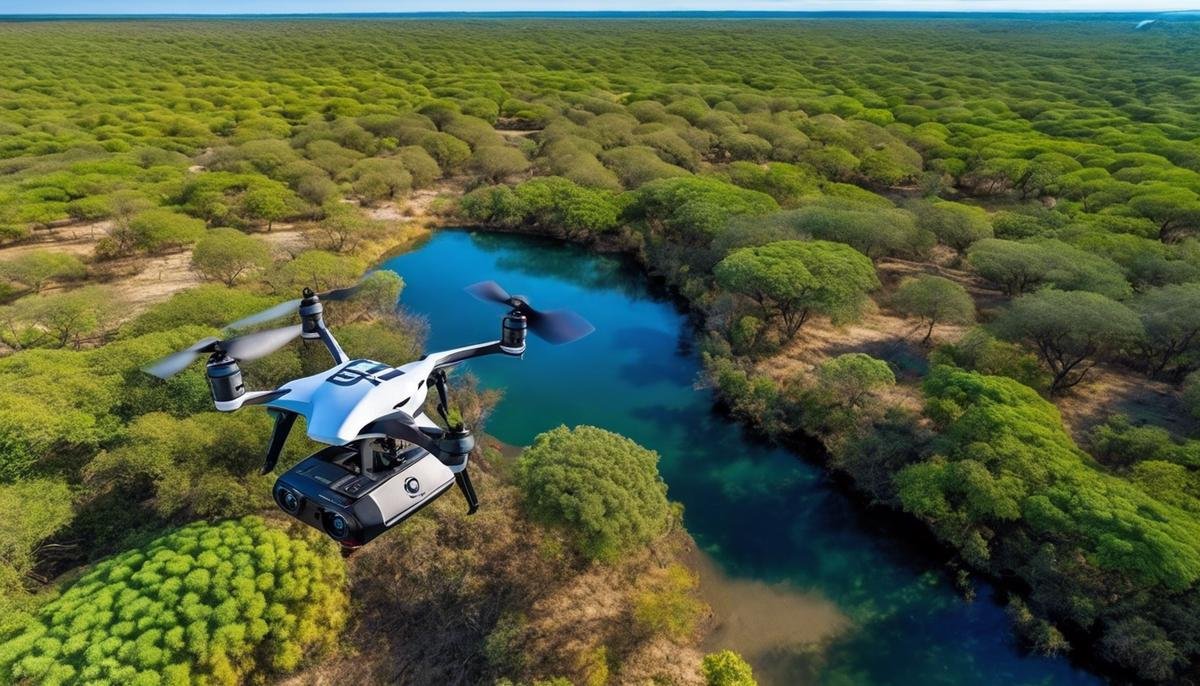Imagine a world where forests manage themselves, oceans keep their own records, and wildlife conduct their own censuses. It’s not just a scene from a sci-fi movie—this is the new frontier of environmental conservation powered by artificial intelligence, AI. From the depths of the ocean to the peaks of the highest mountains, AI is already taking us leaps forward in protecting the world around us. It’s guiding us to smarter decisions, helping us see patterns we never noticed, and teaching us to understand our planet in ways that were once beyond our reach. Join us as we dive into the virtual minds that are working tirelessly to save the actual earth.
Current State of AI in Environmental Conservation
AI Redefining Conservation Efforts: A Closer Look at Technological Advancements
Artificial Intelligence (AI), a rapidly developing field, is reshaping conservation efforts, offering hope for ecosystems and endangered species across the globe. This technology has become a game-changer, providing innovative solutions to some of the most pressing environmental challenges.
At its core, AI refers to computer systems designed to perform tasks that usually require human intelligence. These tasks include reasoning, learning from experience, discerning patterns, and making decisions. In the realm of conservation, AI allows for effective monitoring, data collection, and analysis, leading to more informed decisions to protect wildlife and habitats.
One of the primary ways in which AI is used in conservation is through the analysis of vast amounts of data. Conservationists can feed images from camera traps, drones, and satellite imagery into AI algorithms, which can identify species, count individual animals, and even detect poachers. This data-driven approach offers unprecedented accuracy and efficiency compared to traditional methods.
Deep learning algorithms are also transforming our understanding of ecosystems. Through sound, AI can monitor and identify bird calls or underwater marine life, providing real-time insights into species diversity and population dynamics. For instance, scientists are employing AI to listen to the rainforest, identifying sounds of illegal logging or distressed wildlife, enabling faster reaction times to protect the environment.
Another area where AI excels is in predictive analytics. By analyzing patterns and trends, AI can forecast potential threats to biodiversity, such as disease outbreaks or the effects of climate change on specific species. Conservationists are employing these predictive models to focus their efforts more strategically and preemptively.
AI doesn’t operate alone in these environments. It is commonly paired with other technologies, like geographic information systems (GIS) and various forms of robotics, to enhance its impact. Drones, for instance, are increasingly equipped with AI to cover large areas and inaccessible terrain, offering a bird’s-eye view that is critical for species monitoring and habitat assessment.
In combating poaching, AI’s role is becoming increasingly sophisticated. Machine learning algorithms are being developed to predict poaching events by analyzing historical data, patrol patterns, and animal movement. These algorithms help to optimize patrol routes and resource allocation for anti-poaching units, making conservation efforts more effective and efficient.
AI is also facilitating citizen science, engaging the public in conservation efforts. Apps powered by AI enable everyday people to identify species or report environmental concerns, contributing to data collection and fostering a greater connection between communities and the natural world they co-habit.
Despite the potential of AI in conservation, some challenges persist. High costs, the need for technical expertise, and concerns about data privacy and ethical considerations are among the difficulties faced when implementing these technologies. Conservationists and technologists must work hand-in-hand to address these issues, ensuring that AI tools remain accessible, transparent, and grounded in ethical use frameworks.
The partnership between AI and conservation is indeed redefining the field, providing powerful tools to protect the planet’s biodiversity. With continued innovation and careful adoption, the use of AI stands to make substantial strides in preserving the natural world for future generations.

Challenges and Limitations of Using AI
Harnessing the power of AI for conservation presents a kaleidoscope of opportunities.
As intelligent technology penetrates the verdant realms where wild things roam, it sets the stage for trailblazing strategies to preserve our planet’s biological tapestry. However, the journey is not without its hurdles. The troubles shooting up from the fertile ground of innovation require a steady hand and a keen mind to navigate.
One notable obstacle is the disparity in technological advancement across different regions. While conservation is a global concern, not every corner of the world brims with the latest tech or robust infrastructure. AI solutions might be blossoming in one part of the globe, but in under-resourced areas, the seeds of technology haven’t even been sown. The gap in capabilities means that while some benefit from AI’s might, others watch from the sidelines, their conservation efforts limited to what’s within arm’s reach.
Data, the lifeblood of AI, comes with its own set of problems. The integrity and accuracy of data fuel the effectiveness of AI, where even a drop of corruption could skew results and lead to misguided conservation actions. Imagine AI models fed with flawed data, like a GPS gone haywire, drawing experts down the wrong paths and away from the ecosystems most in need of protection.
Moreover, AI’s insatiable appetite for data stirs a cauldron of privacy concerns and the handling of sensitive information. In the enthusiastic embrace of tech, we must not overlook the footprint we leave on the sacrosanct ground of indigenous lands and local communities. The data collected to train conservation AI skirts around territories heavy with cultural significance, and one careless step could trample over the rights and dignity of those who call these lands home.
Then there’s the energy dilemma. AI models, especially the more complex ones, are notorious for their voracious energy consumption. When conservation efforts are powered by AI, we’re faced with the irony of large carbon footprints left by the very tools meant to safeguard nature. The quest for eco-friendly AI is more than just practical—it embodies the ethos of conservation itself.
But it’s not just the nuts and bolts that challenge us. The symbiosis of human and machine intelligence must be nurtured. Building the cadre of experts who can straddle both the natural and digital realms is no small feat. Educating a workforce skilled in AI and passionate about conservation is akin to growing a rare hybrid orchid—it requires time, care, and the right environment to flourish.
Finally, the looming specter of AI’s potential moral conundrums cannot be ignored. Algorithms with the capacity to influence conservation policies wield immense power. Ensuring that this power is governed by a moral compass aligned with the well-being of all earth’s inhabitants is a task that extends beyond the technical—it’s a call to our collective conscience.
In conclusion, the obstacles AI technologies face in conservation are as diverse as life itself. The march towards a future where AI is a trusted ally in our environmental crusades is steady. Yet, each step is taken with the weight of responsibility, as we seek harmony between the silicon of our ambitions and the soil of our shared home.

Innovative AI Tools and Technologies
In the quest to safeguard our planet’s future, cutting-edge AI tools are not just optional—they’re imperative. These advanced systems provide conservationists with an edge, turning the tide in the race to preserve Earth’s delicate ecosystems and the diverse life they support.
One transformative AI tool in the arena of conservation is the use of drones equipped with AI-powered cameras. These high-flying sentinels soar above remote forests, vast oceans, and sprawling savannas to collect real-time imagery. AI algorithms then sift through terabytes of footage to detect changes in land patterns, track animal migrations, and even identify illegal logging or mining activities. This monitoring extends the reach of conservationists, who now can survey endangered species and threatened habitats that were once nearly inaccessible.
Another revolutionary tool is AI-enhanced species recognition systems. Traditionally, monitoring wildlife populations involved manual counting, a method both time-consuming and prone to human error. Now, AI comes into play with its remarkable ability to recognize individual animals through pattern recognition—like the unique stripes of a zebra or the distinctive fluke of a humpback whale. This precision facilitates more accurate population estimates and allows for better-informed decisions on protection strategies.
Beyond the terrestrial and marine realms, AI is also taking root in the fight against deforestation. The AI-driven platform Global Forest Watch utilizes satellites to track deforestation events in near-real-time. This watchful eye in the sky empowers conservationists and policymakers with actionable data to respond swiftly to illegal clear-cutting, ensuring timely interventions and stronger enforcement of environmental laws.
Moreover, AI-driven genetic analysis is breaking new ground. Scientists can now deploy AI to analyze DNA samples from the environment—a technique known as eDNA—to detect the presence of rare and elusive species. This non-invasive method sidesteps the need for direct observation or capture, minimizing human impact on the natural habitat. It also enhances the understanding of biodiversity at the genetic level, which is critical for conservation planning and the management of genetic diversity.
Lastly, AI is catalyzing a wave of ‘smart’ conservation efforts in urban environments. Cities are deploying AI to optimize the management of green spaces, monitor air and water quality, and ensure sustainable urban planning. AI models simulate various scenarios, predicting how urban development will influence local wildlife and ecosystems. These insights are crucial for city planners who aim to create sustainable cities that are not only livable for humans but also hospitable to native flora and fauna.
Incorporating these cutting-edge AI tools into conservation strategies represents a significant leap forward. The synergy between innovative technology and traditional preservation methods unfolds a new chapter in conservation—one that’s data-driven, efficient, and more responsive to the pressing environmental challenges of our time. As we continue to harness the power of AI in our stewardship of the natural world, we pave the way for a future where both humanity and nature can thrive in harmony.

AI’s Role in Public Engagement and Policy Making
Artificial intelligence is reshaping the landscape of public engagement and environmental policy in unprecedented ways.
Public participation is crucial for successful environmental initiatives, yet historically, it’s been challenging to achieve broad involvement. AI is now bridging this gap by enabling more interactive and insightful platforms for public discourse.
AI-driven tools are simplifying the process of gathering public opinion. Through sophisticated algorithms, AI systems can analyze large volumes of feedback from social media, dedicated forums, and online surveys. This provides policymakers with a more nuanced understanding of public sentiment, allowing them to tailor policies that garner widespread support.
Moreover, AI is making environmental information more accessible to the general populace. With the help of machine learning techniques, complex data about climate change, biodiversity loss, and pollution is transformed into engaging and informative visualizations. These tools empower citizens to comprehend the gravity of ecological challenges and encourage them to participate actively in environmental stewardship.
Environmental policy is also benefiting from the predictive power of artificial intelligence. AI models are capable of forecasting environmental trends, thus informing policymakers about potential future challenges. This foresight aids in crafting forward-thinking policies designed to avert ecological crises before they escalate. For example, AI algorithms can predict the spread of invasive species or the impact of climate change on water resources, allowing for proactive policy measures.
AI’s influence extends into the legislative process, where it assists in the analysis of existing policies and regulations. By scrutinizing vast amounts of legal documents, AI can identify gaps in environmental legislation and propose amendments. This ensures that environmental laws are robust, comprehensive, and up-to-date with the latest scientific findings.
In the realm of law enforcement, AI is a game-changer for environmental regulations. Enforcement agencies use AI to monitor compliance and detect infractions. With the help of satellite imagery analysis and automated reporting systems, it is easier to spot illegal activities, like unauthorized logging or wildlife trafficking. This not only enhances the effectiveness of law enforcement but also deters potential violators.
Public consultations are another area where AI is making a mark. By facilitating virtual town hall meetings and forums, AI-powered platforms enable more people to participate in discussions about environmental policies. This inclusivity is pivotal, as it ensures diverse viewpoints are considered, leading to more equitable and effective environmental governance.
To sum up, artificial intelligence is revolutionizing public engagement and environmental policy by enhancing interaction, information dissemination, and policy formation. It fosters an inclusive dialogue around environmental issues and provides valuable insights that guide the creation of more effective and preventive measures. As AI technology evolves, its potential to drive meaningful change in environmental policy and engagement is bound only to increase, pointing towards a future where public voice and ecological sustainability can harmoniously coexist.

Future Projections and Ethical Considerations
Looking ahead, the interplay between artificial intelligence and environmental conservation seems poised to unfold in ever more transformative ways. Innovations in AI hold the promise of not only streamlining present efforts but also unveiling entirely new strategies in our quest to nurture biodiversity and manage natural resources sustainably. This foresight into AI’s trajectory points towards a future where technology and ecology entwine to forge a resilient environment.
AI systems are becoming increasingly adept at behavioral prediction, a tool that could redefine habitat preservation. By sifting through historical data and current observations, these systems will forecast the migration patterns of endangered species, allowing for preemptive measures to secure vital corridors and mitigate human-wildlife conflict. On a larger scale, climate models infused with AI could enhance our understanding of environmental shifts, enabling us to adapt conservation strategies in real-time to protect vulnerable ecosystems.
The role of AI in environmental restoration is also an avenue ripe for exploration. Programs designed to analyze past reforestation efforts could direct future projects more efficiently, selecting the right species and planting schemes for optimal growth and biodiversity. Moreover, AI could enhance soil recovery by analyzing data on nutrient levels and moisture content, ensuring that each parcel of land receives tailor-made treatment to foster a return to fertility.
In marine conservation, AI technologies may soon patrol the oceans – not just on the surface, but across the depths. Imagine autonomous underwater vehicles that map coral reef health or track the populations of marine mammals, providing insights far beyond human reach. AI algorithms would then mine this data to suggest specific conservation actions, such as identifying areas for marine protected zones or initiating coral breeding programs to rehabilitate damaged reefs.
On the societal front, the potential for AI to revolutionize environmental legislation is tremendous. Future AI systems could compare environmental outcomes with legislation across different geopolitical landscapes, discerning which regulations are most effective. This could lead to a global exchange of best practices, with AI providing recommendations for policy refinements to balance human development with ecological imperatives.
Advancements in AI are also projected to foster greater transparency in environmental management. Through real-time environmental monitoring and data dissemination, AI will empower communities to hold industries and governments accountable. Citizens and policymakers alike could have immediate access to information on air and water quality, deforestation rates, or industrial compliance with environmental guidelines, making for a more informed and responsive civic process.
AI’s potential to enhance renewable energy sources could also prove to be a game changer for both the environment and our energy systems. Optimal placement of wind turbines, predictive maintenance for solar panels, and efficient grid management are all within the scope of AI-assisted technologies. This could not only lower the carbon footprint but also streamline the integration of green energy into our daily lives.
In agricultural spheres, AI could be the key to sustainable practices that feed our growing population without further harm to the planet. Precision farming enabled by AI can minimize resource use and reduce harmful runoff, all while boosting crop yields. Through AI, we can envision a system of agriculture that coexists harmoniously with natural ecosystems rather than displacing them.
The road ahead for AI in environmental conservation is both broad and bright. While we stand at the intersection of innovation and nature, the journey forward is not without its obstacles. Technical, financial, and ethical challenges will no doubt arise, but the indomitable spirit of human ingenuity, coupled with a commitment to the natural world, promises to steer AI toward a future in which it serves as a cornerstone of environmental guardianship and a partner in securing the health of our planet for generations to come.

Our journey through the digital savannas and silicon forests of AI in environmental conservation has given us a glance at both the promises and perils of this rapidly evolving technology. As we explore the many ways AI can serve our planet, we’re reminded that with great power comes a considerable responsibility; to tread carefully, think critically, and act compassionately. The AI tools we forge today will shape the legacy of tomorrow’s earth. It’s a world interwoven with data and decisions, where our commitment to conservation isn’t just about the technology we create, but the thoughtful way we choose to wield it.



